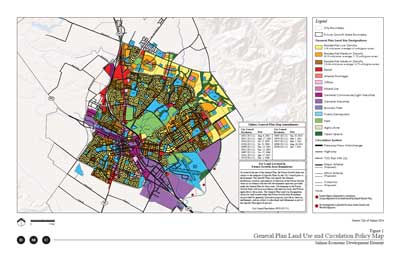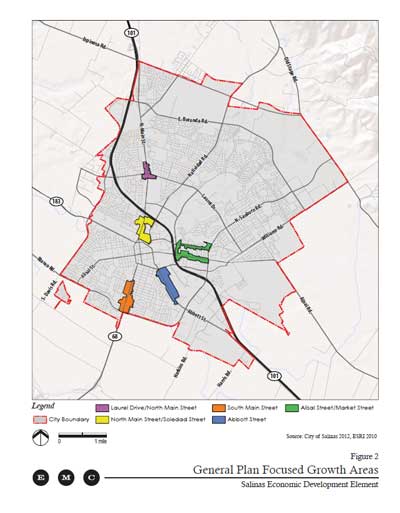Economic Development Element
The City of Salinas is drafting an Economic Development Plan within its existing (2002) General Plan to create jobs and generate revenue. The City recognizes the region to be one of the epicenters of agricultural production in the nation. The City wants to capitalize on the agricultural components and add business innovation and agricultural technology.
Quick Facts
- The project applicant is the City of Salinas.
- The City of Salinas prepared an Economic Development Element to add to its 2002 General Plan.
- The Plan is a tool to overcome various economic constraints and capture economic opportunities
- The City of Salinas is the Lead Agency.
Project Status
- The City of Salinas has asked Monterey County to support the City’s expansion south onto prime farmland — an expansion that is currently prevented by a memorandum of understanding (MOU) between the County and the City. Update available. (06.14.18)
- The Salinas City Council unanimously approved the EDE and Final EIR on December 5, 2017.
- The Salinas Planning Commission voted 3-3 to deny certification of the Final EIR at its November 15, 2017 meeting.
- The Notice of Preparation of an Environmental Impact Report (4.1M PDF) was released by the City of Salinas on October 11, 2015.
- The draft Economic Development Element (9M PDF) was made available in April 2014.
- The Salinas City Council unanimously voted to approve the Economic Development Plan on June 17, 2014.
Project Location Map
This map shows the General Plan Land
Use and Circulation Map.

Full Size Map (1.6M PDF)
Credit: City of Salinas Economic Development Element (April 2014)
This map shows the Focused Growth Areas of
the Economic Development Element.

Full Size Map (1.1M PDF)
Credit: City of Salinas Economic Development Element (April 2014)
Resources at Risk
- Consider Alternatives to Annexation
Lack of available land for commercial and industrial development is identified as a major constraint to economic growth throughout the document. The element should address a general plan amendment that would redesignate the 3,400 acres currently designated for residential development that have remain largely vacant for the past 12 years. - Inadequate Use of Existing Areas of Commercial/Retail/Mixed Use
The existing area within the City is designated for 3,992 million square feet of commercial/retail/mixed use and public and semi-public uses. LandWatch wonders why more is needed when so much existing space is available? - Encourage Infill & Redevelopment
It is generally accepted that new commercial development on the boundaries of a local jurisdiction discourages infill. The element should include policies that require development within existing commercial and industrial areas prior to expanding to the areas adjacent to the City.
LandWatch Involvement
LandWatch engages in the public process in a variety of ways. For this project, here is a list of our engagement strategies.
- Letter: LandWatch Supports Downtown Mixed Use Plan (487K PDF)
The Salinas Downtown Vibrancy Plan was a multi-year initiative intended to foster economic renewal for Salinas’s downtown. LandWatch strongly support the Plan’s focus on encouraging mixed-use development with an emphasis on apartments as well as creating a pedestrian and bicycle-friendly downtown. (03.19.19) - Request: LandWatch Asks Supporters to Contact County
Earlier this week, we sent an email on the long-standing agreement between the County and the City of Salinas that prevents the City of Salinas from expanding south onto prime farmland. We anticipated the item to be heard next Tuesday, but it has now been delayed to Tuesday, July 10th. (06.15.18) - Request: LandWatch Urges County to Hold Line on Salinas Growth
On June 19, 2018 at ~10:30 am, the Monterey County Board of Supervisors will consider whether to support a long-standing agreement between the County and the City of Salinas that prevents the City of Salinas from expanding south onto prime farmland. Please email or call the County Board of Supervisors and urge them to oppose sprawl and encourage city-centered growth. (06.13.18) - Testimony: Before the Salinas City Council (527K PDF)
LandWatch Executive Director Michael DeLapa provides critical testimony to the Salinas City Council. He requested they reject the Final EIR, create a better economic development element that is more in line with the area, analyze infill as an option, and mitigates impacts for externalities. (11.28.17) - Comments: LandWatch Comments on Final EIR (574K PDF)
LandWatch urges the City Council to vote against certification of the FEIR for multiple reasons and urges the Council to protect farmlands, reduce housing costs, reduce traffic congestion, and revitalize urban areas. (12.04.17) - Letter: Salinas Economic Development Element Comments (887K PDF)
LandWatch submitted this letter to Salinas promoting more infill, less sprawl will brighten Salinas’ economic future by encouraging reinvestment in neighborhoods and the city center. (10.23.17) - Letter: Comments on the Notice of Preparation (140K PDF)
LandWatch submitted comments requesting analysis of alternatives, baseline conditions, and cumulative water analysis. (11.30.15) - Letter: Comments on the Draft General Plan and Economic Development Element (135K PDF)
LandWatch outlines comments related to annexation; areas for mixed use, retail, and commercial; infill; vacant buildings; and agricultural easements. (06.02.14)
Project History
- Sam Farr Submits Letter on Annexations (227K PDF file)
Retired Congressman Sam Farr outlines multiple reasons why the annexation of lands in Salinas across Blanco and Davis Roads shouldn’t occur. In his letter, he reminds Supervisor Parker that the County has taken multiple hard positions on these roads being urban limit lines. Farr supported revitalizing the downtowns and stopping sprawl. (06.22.18) - Millions of Farmland Acres Lost to Development
Salinas’ Economic Development Element proposes to pave over valuable Monterey County farmland. Absolutely unnecessary. “According to the American Farmland Trust, the United States lost almost 31 million acres, or 3.2 percent of its total farmland, from 1992 to 2012. California, which is responsible for one-eighth of the country’s farm production, lost an estimated 1.3 million acres of agricultural land to development during the same time period as both the state and the U.S. population increased by 22 percent. (05.08.18) - LAFCO Provides Comments on Salinas EDE
The Local Agency Formation Commission (LAFCO) provided substantive comments on the Draft EIR. The Commission outlines in a 19 page letter its concerns with consistency with LAFCO policies. (10.24.17) - Controversial Plot to Expand Outward
LandWatch Executive Director, Michael DeLapa is quoted in this article that, “If you’re investing in sprawl, you’re not investing in redevelopment.” He continues, “If you go outside, you can harm interior businesses. That’s what we see when we get sprawling retail big box stores: Downtown hardware stores, they die. Then you’ve got this big vacuum in your urban area.” (10.19.17) - Ag vs. Houses – Salinas Plan Picks Houses
Salinas is city amidst the farmlands. The City’s economic development plan outlines conversion of prime ag lands (15,000 acres to be exact) to houses. Our very own Amy White commented that prime ag lands should be the very LAST resort. (12.03.15) - Debate Over Infill or Industry in Salinas
Advocates relayed concern over the City’s Economic Development Plan, which threatens the agriculture in the City by replacing it with industrial complexes. The City Council unanimously approved the Plan on June 17. Next steps include evaluating costs, impacts and updates to the General Plan. (06.19.14) - Economic Development Plan Takes Land Out of Production
The City unveiled a long-term economic development plan which is meant to guide the City over the next 35 years. The plan proposes to remove prime agricultural land from production. Many officials and advocates are concerned. LandWatch Executive Director Amy White is quoted in the article. (05.01.14)
Salinas Valley
Issues & Actions
